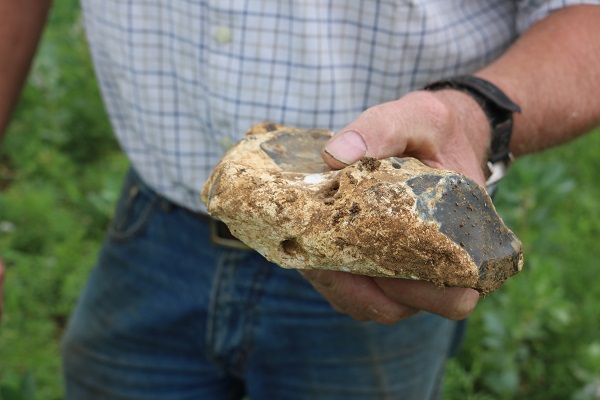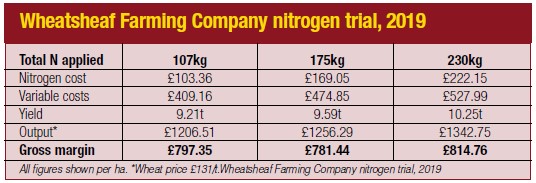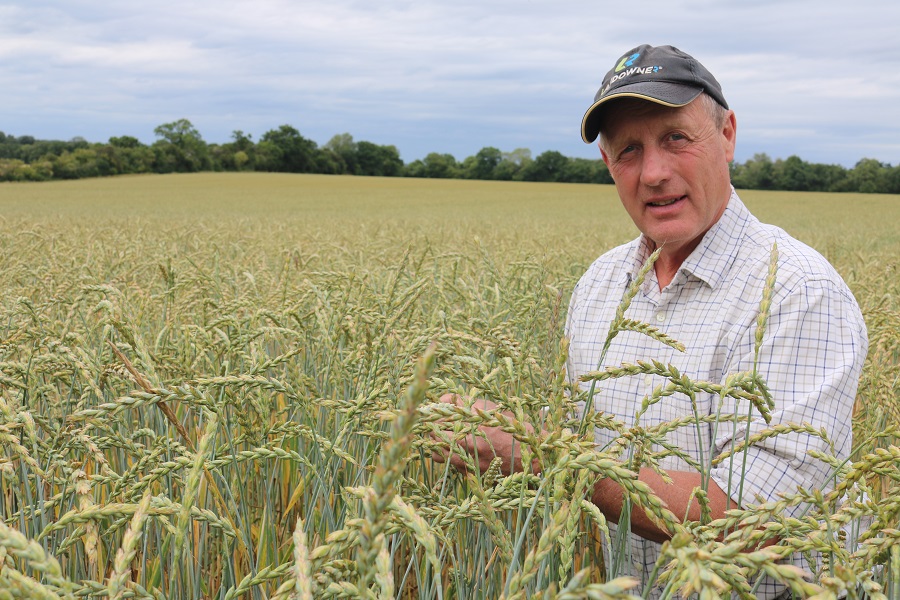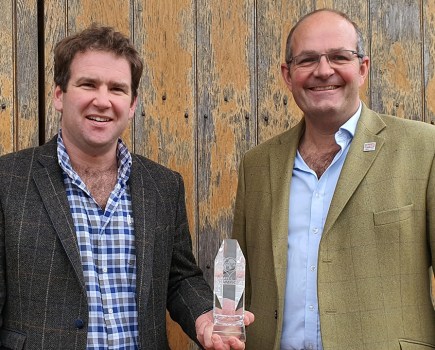While direct drilling and cover crops are the main drivers of sustainability for Hants grower David Miller, a focus on soil and crop health have helped him step up his green credentials. CPM visits to find out more.
The route to retaining crop performance without costs rising higher was to look at improving soil health.
By Tom Allen-Stevens
Its visual appeal isn’t the only stunning attribute of David Miller’s spelt wheat. Buoyant demand from a health-conscious consumer gives it an attractive market price. And for David, it’s the resource that goes into it (or lack of this) that’s equally appealing.
“Most spelt wheat is organic, and it’s a crop that looks after itself – it needs just 120kgN/ha and a touch of fungicide. Growth regulator is the biggest concern. But it’s ideal in an integrated pest management (IPM) situation, and while more modern wheats struggled during this difficult season, the spelt motored through,” he says.
Sown at 200kg/ha, David drilled the crop crosswise to improve the plant stand and reduce the risk of lodging. He’s expecting 7t/ha, half of which comes out through dehulling. “It’s early to combine, harvested in front of wheat, so fits in well with the rotation,” he adds.

The no-till system has to cope with abrasive flinty soils.
The crop is indicative of the direction taken by the Wheatsheaf Farming Company, based near Basingstoke, Hants. The business comprises three farms, cropping a total of around 700ha across light soils over chalk with heavier clay caps, all with a high flint content. As farm manager, David Miller believes there’s a strong business case for the direct drilling and cover crops policies he’s pursuing.
“They tie in well with the regenerative agriculture gambit,” he says. “We’ve used the Farm Carbon Calculator to assess our greenhouse gas (GHG) emissions and we’re now getting a handle on the big-picture stuff. Fertiliser use and soil organic matter (SOM) make the biggest contribution and our current farming policy happily takes us very much in the right direction.”
But it wasn’t a pursuit of lower carbon emissions that prompted David to start investigating the potential for cover crops. There’s a fairly standard four/five-year rotation of winter wheat, barley and oilseed rape with some winter beans, and spring barley, peas and linseed. Cover and catch crops play an increasingly important role in the cropping mix, allowing David to reduce the break crops that he sees as unreliable, and increase the cereals, bringing in a second wheat.
“We first started to look at cover crops in 2010. Our yields had hit a plateau but costs were rising. We were doing a good job, however – wheat was averaging around 10t/ha, with OSR at 5t/ha. The route to retaining that performance without costs rising higher was to look at improving soil health.”
On the face of it, a £30/ha seed cost from cover crops with no cash output would be unlikely to bring the desired objective in the short term, David admits, and he’s learned how to refine the cropping choice to get the best out these soil improvers. “We used to have oil radish, which took up available N, but was a haven for slugs, and we soon realised it’s best to keep cereals and brassicas out of the cover crop.”
He now grows his own seed – a 5ha field sown with 100kg/ha of lupins and 50kg/ha each of beans and vetch, all harvested together. Wandering through the crop as the pods are forming, you can see how the three complement each other, while there’s a profusion of bees taking advantage of the ultra-low input flowering crop.
“Vetch can be a nightmare to harvest, but hopefully the beans and lupins will keep them off the ground. We’ve gone for Avalon beans, which produce very small seed – more in line with the two companion crops – you get more seeds per plant, so value for money,” David points out.
The other key change, that has gone hand-in-hand with the cropping, has been a switch to direct drilling. “You make more of cover crops by not moving the soil – the whole is greater than the sum of its parts,” he notes.
“Initially we had a 4m Horsch Sprinter which we modified with narrow Metcalfe points. But to really get the benefit of no till, you’ve got to go for a disc coulter. The John Deere 750A and Weaving drills are no match for our abrasive flinty soils. So we purchased a 6m Cross Slot in 2015.”
A pass with the straw rake directly after the combine is swiftly followed by the drill that slots in the cover crops. With minimal soil disturbance, weeds are becoming less of a problem, says David, allowing him to establish cash crops earlier. Diesel usage has dropped from around 85 l/ha to 60 l/ha with the switch to no till, and David’s noticed a more friable tilth has developed, with the surface soil looking darker.
But it’s been a long journey – he recalls he struggled to get crops established at first. “Without moving the soil, it lacked the mineralised N, so we got a derogation to apply DAP in the autumn. This is a stepping stone, though – as the soil’s improved year on year, we’ve been able to reduce this, and now the soil’s biological activity does the job of the DAP.”
More sustainable crop
Moving forward, David is now working with Mike Harrington of Edaphos and has applied similar tweaks to other aspects of crop agronomy that have not only addressed the challenges he’s faced, but lowered costs and ensured a more sustainable crop. “Slugs have been our nemesis, but we’re applying very few pellets these days. Pitfall-trap monitoring has shown we have a fantastic level of beneficials in the cover crops, so we do all we can to look after them. It’s a win-win for both costs and crop protection.”
With OSR, David is glad to have left behind the days when he “shoved money at the crop”. His current approach is to use farm-saved seed, drilled with four or five companion crops, including fenugreek, buckwheat, berseem and crimson clover and camelina, again with no insecticide. “Farming practice has screwed up OSR, and 80% of cabbage stem flea beetle are now resistant to pyrethroids. That means if you use them, you’re just taking out the beneficials and giving the beetle a free rein. We’re applying garlic oil to ward off the CSFB, but if we lose the battle, we’ll still have a good cover crop,” he says.
It’s this approach of aligning agronomy to the crop and the soil, rather than simply managing the crop, that’s reflected throughout the system. David insists he hasn’t been drawn towards any one ideal, although a reduced reliance on chemistry is a core theme. “However you look at it, chemicals are detrimental to the crop and the soil, so wherever we can, we choose a different approach. Hopefully we’re encouraging the biology to work more with us, and that has benefits for carbon emissions too.”
This IPM approach has brought clear financial savings, but assessing the carbon benefits has been tricky, he admits. The manufacture and application of chemicals add relatively little directly to overall emissions of crop production, according to the carbon accounting tool he’s used, while the contribution of IPM to SOM is somewhat tenable. But he feels it has a greater role in protecting yield as well as bringing significant environmental and economic benefits.
Even assessing SOM has been difficult – although David’s convinced this is improving, he’s recently changed from measuring it through loss on ignition to the Dumas method, so can’t necessarily quantify the progress he’s made. He also questions whether additions such as chicken muck and biosolids are used as a “quick fix” for improving SOM, preferring cropping and reduced cultivations as the more reliable, “natural” routes to long term benefits.
But there’s one “big-picture” aspect he is looking to get to grips with – nutrition and more specifically nitrogen use. “We did some tramline trials last year, varying N from 107kgN/ha to 230kgN/ha. The results showed an extra 1t/ha yield, but at what cost? It’s not just the fertiliser – a more growy crop brings in more disease, with resulting fungicide and other costs. The margin we achieved was less than £17/ha.”

So for 2020, David’s “moved it up a gear”. One field of KWS Extase has been split along the tramlines with five different N regimes, from a total applied of 108-218kgN/ha. No T0 spray has been applied on the treatment areas to compare this with the farm standard control.
“It’s not just about yield, or even margin. We have an N-Sensor and in future we plan to use it to generate chlorophyll maps through the season to monitor crop health. I hope these trials will give us a greater understanding of how we balance nitrogen, fungicide inputs and variety to optimise performance, in every sense of the word,” says David.
He believes he’s made a good start with the cover crops and no-till approach, setting a system where crop and soil health complement each other to build a system that will become progressively more profitable, as well as sustainable. “Plant nutrition is where our focus lies at the moment. It’s difficult to know exactly what the right route will be, but we’re trying to put more science into helping us find the direction to take.
“The next challenges are to develop the market for this way of farming and for it be recognised with the new Environmental Land Management (ELM) Scheme. I’m glad we’re doing what we’re doing, and we’ve followed it for long enough we can see the benefits. But we’re doing it because it’s the right way to farm. As ELM and market opportunities develop, hopefully these will go with us,” concludes David.
What makes David Miller a Climate Change Champion?
Innovative ideas
David’s approach has been to manage crops in “the right way” for his farm. He’s adapted techniques, centred on cover crops and no till, with experience and on-going testing providing the direction. New ideas are tailored to complement progress made.
Productivity push
The aim has been positive progress through better use of resources, looking beyond mere yield gains or margin benefits. This has been achieved through judicious application of IPM techniques and a firm focus on improving soil health, resulting in a more sustainable system.
Cultivation care
The move to direct drilling has gone hand-in-hand with cover crops. Again, a focus on soil health has been at the heart of progress, with emissions cut by 66%, and friability, worm counts and biological activity also improving.
Bio-based boldness
Wheatsheaf is one of a number of farming businesses exploring the use of biochar for its potential to capture carbon and improve soils.
British farmers show the way to net zero
You may be surprised at the contribution you’re already making to the NFU’s target for agriculture to reach net zero emissions by 2040. It’s recently published 26 examples of how farmers are working towards net zero on their farms.
Examples include increasing soil health and fertility, undertaking precise tree planting and woodland management, investing in new technologies to increase productivity and creating biomass and renewable energy to power the farm and local areas.
“British farmers are ambitious and we want to be the global leader when it comes to climate-friendly food,” says NFU deputy president Stuart Roberts, who features as one of the case studies.
“Our goal of net zero agriculture by 2040 means the industry as a whole being a net zero contributor to climate change. It’s a challenge but by coming together to encourage progress it can be done, and it will also help improve our business resilience as well as our environment.”
The NFU has identified three pillars: improving productivity, increasing carbon stores and boosting renewables and bioenergy production. Stuart encourages farmers to assess what they may be doing on their farm and the net contribution it makes. The NFU’s Farm Status Indicator is a simple tool that gives you a guide to the practical measures you can take, while it’s also reviewed three carbon calculators used to assess progress: Cool Farm Tool, Farm Carbon Calculator and AgRE Calc.
“We recognise that each farmer will be starting their net zero journey from a different place. Whether they’re at the start of this journey or well on the way, every farm and business model has something it can offer,” adds Stuart. www.nfuonline.com/cross-sector/environment/climate-change/
From the end of this month, CPM readers and NFU members will get the chance to vote on who they feel should be awarded arable Climate Change Champion 2020, from the nine farmers featured in CPM throughout the year. There’ll also be the opportunity to put yourself forward as a contender for 2021 – CPM and NFU are keen to identify more farmers with inspirational ideas to achieve net zero. www.cpm-magazine.co.uk/climatechangechampions
Climate Change Champions
UK Farming has set itself the challenging target of Net Zero emissions by 2040. Although led by the NFU, it will take the entire industry, working together in a partnership approach to meet this ambitious goal.
But there are individual growers, thought leaders who have already started on this journey. They have the ideas, the progressive outlook and the determination to shape positive change. CPM has teamed up with leading agricultural suppliers who have a credible Net Zero aspiration to identify these individuals and bring them into the top-level discussion about how farming can position itself as the solution to climate change.




